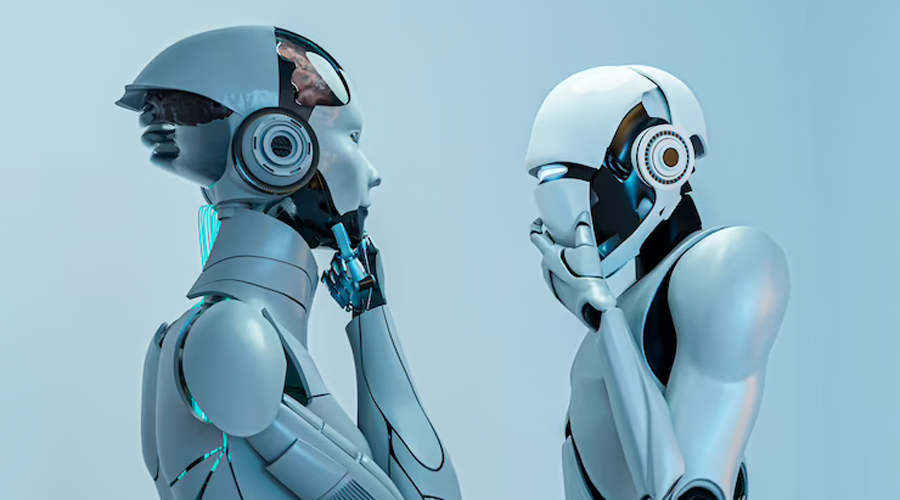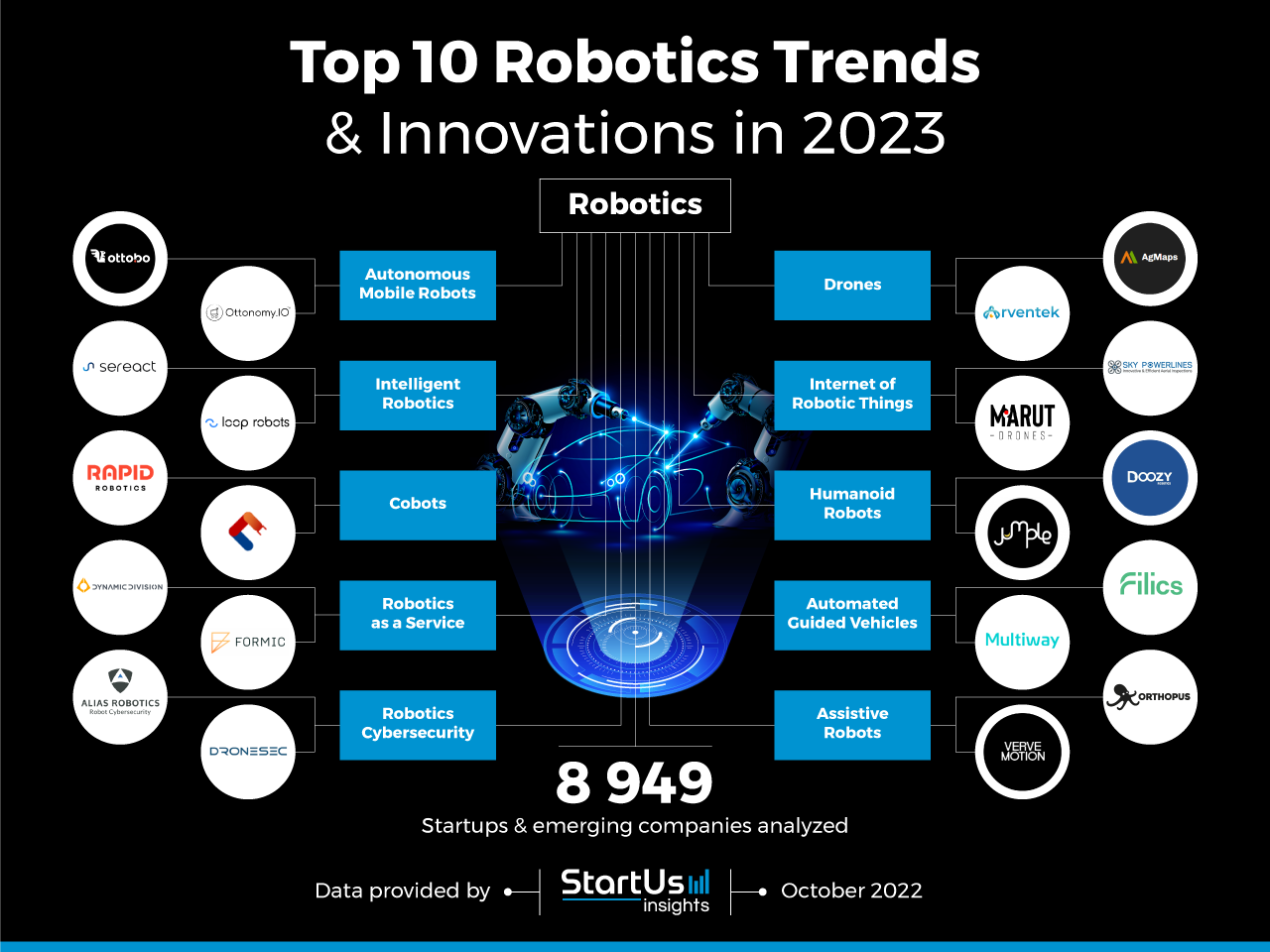TECHNOLOGY
Impact of Smart Robots in Industry 4.0

Smart robots in industry 4.0 help businesses achieve higher automation, flexibility and efficiency levels while improving safety and lowering the risk of errors and accidents.
Since the 1800s, humanity has experienced three industrial revolutions, each marked by an innovative technology transforming manufacturing and processes. The steam engine, assembly line and computer propelled previous courses. We are now amid industry 4.0 – the current industrial revolution – powered by robotics, automation and the Internet of Things (IoT). The emergence of smart systems and digital integration has caused significant disruption in almost every industry worldwide. The manufacturing and industrial landscape is undergoing significant change today as we enter the fourth industrial revolution. The rise of smart robots in industry 4.0 is revolutionizing how we work and produce goods. Smart robots are designed to work alongside humans, performing repetitive, dangerous roles or tasks requiring a level of precision that humans cannot consistently achieve. They are embedded with advanced sensors, artificial intelligence and machine learning algorithms that allow them to learn, adapt and improve over time. The impact of smart robots in industry 4.0 is already felt in various sectors, from automotive and electronics to healthcare and logistics. They are revolutionizing how products are designed, manufactured and delivered, making the process faster, more efficient and less expensive.
Smart robots in industry 4.0 are enhancing various tasks to make organizational processes more efficient and effective by:
PROVIDING PREDICTIVE MAINTENANCE
Smart robots in industry 4.0 can provide predictive maintenance by detecting and analyzing data from equipment and machines using advanced sensors and machine learning algorithms. They can identify potential issues before they cause a breakdown or failure by monitoring performance data such as temperature, vibration and other indicators. Additionally, using predictive maintenance, smart robots in industry 4.0 can predict when equipment will require maintenance, repair or replacement and schedule maintenance activities in advance. This method can reduce downtime, boost productivity and extend machinery life, resulting in significant business cost savings.
ENHANCING PRODUCT QUALITY
Thanks to advanced sensors, machine learning algorithms and data analysis capabilities, smart robots in industry 4.0 can improve product quality in various ways. For starters, these robots can detect product flaws during manufacturing, allowing for rapid identification and correction of problems. They can also detect errors that human inspectors might miss using sensors to measure product dimensions, weight and appearance. This reduces the number of defective products reaching the market, improving overall product quality. Furthermore, intelligent robots can monitor production processes in real time, adjusting settings to improve quality and reduce defects. A smart robot, for example, may adjust the temperature, pressure or speed of a production line based on data collected from sensors, resulting in higher-quality products.
IMPROVING PRODUCTIVITY
Smart robots in industry 4.0 are programmed to perform repetitive or monotonous tasks, liberating manual workers to focus on more complex tasks. Automation can provide a significant advantage for large manufacturing operations by allowing tasks to be completed around the clock without incurring additional labor costs. Small businesses, which typically lack the resources to hire large workforces, could benefit significantly from effective task automation. Small businesses can compete on a more level playing field with larger manufacturing companies by using robots to handle specific tasks.
DECREASING OVERHEAD COSTS
Although automated software and robots have a high initial cost, they can provide quick returns on investment. By utilizing smart robots in industrial 4.0, business owners may discover that certain job positions are no longer required, resulting in immediate cost savings. Also, fewer employees would be exposed to hazardous working conditions so that businesses could save money on health and safety costs due to fewer injuries or absences. Many robots require little space and can work safely alongside humans on assembly lines. As a result of the reduced space requirement, businesses may be able to downsize to less expensive workplaces and factories.
ELIMINATING HUMAN ERROR
Smart robots in industry 4.0 can eliminate human error by taking over tasks prone to errors or inconsistencies, improving accuracy and lowering the risk of errors. They can perform precision and accuracy tasks like product assembly or quality control inspections. These robots are programmed to detect even minor deviations from standards and make corrections automatically, ensuring that every product is produced to the highest possible standard, thanks to advanced sensors and machine learning algorithms. Furthermore, smart robots can reduce the risk of human error in dangerous environments by performing hazardous or physically demanding tasks for humans. Robots, for instance, can handle tasks involving toxic chemicals or high temperatures, lowering the risk of accidents and injuries.
ALLOWING COLLABORATIVE WORK
Processing plants in traditional manufacturing facilities operate independently, reducing opportunities to share knowledge or collaborate with other plants. Smart robots in industry 4.0, on the other hand, enable employees to communicate and share information regardless of location or time zone. This means that knowledge gained from one machine or facility can be shared with other processing plants throughout the organization, increasing overall productivity. An advantage of industry 4.0 is the ability to share knowledge between systems or machines without human intervention automatically. For example, data collected from a machine in one location can improve production processes in other facilities worldwide. Businesses can use their entire organization’s knowledge to drive innovation and improve performance.
Industry 4.0 ushers in a new era of manufacturing and production, propelled by advanced technologies like robotics, automation and the Internet of Things. Smart robots in industry 4.0 are at the vanguard of this revolution, offering numerous advantages such as improved product quality, predictive maintenance and increased efficiency. They take on repetitive tasks, allowing human workers to focus on more complex duties while lowering human errors and refining accuracy. They also allow tasks to be completed around the clock, increasing output while incurring no additional labor costs. As the fourth industrial revolution gains traction, the role of smart robots will become even more important. Manufacturers can streamline operations, increase efficiency and stay ahead of the competition in an ever-changing global marketplace by leveraging the power of these advanced technologies.
TECHNOLOGY
Next-gen chips, Amazon Q, and speedy S3

AWS re:Invent, which has been taking place from November 27 and runs to December 1, has had its usual plethora of announcements: a total of 21 at time of print.
Perhaps not surprisingly, given the huge potential impact of generative AI – ChatGPT officially turns one year old today – a lot of focus has been on the AI side for AWS’ announcements, including a major partnership inked with NVIDIA across infrastructure, software, and services.
Yet there has been plenty more announced at the Las Vegas jamboree besides. Here, CloudTech rounds up the best of the rest:
Next-generation chips
This was the other major AI-focused announcement at re:Invent: the launch of two new chips, AWS Graviton4 and AWS Trainium2, for training and running AI and machine learning (ML) models, among other customer workloads. Graviton4 shapes up against its predecessor with 30% better compute performance, 50% more cores and 75% more memory bandwidth, while Trainium2 delivers up to four times faster training than before and will be able to be deployed in EC2 UltraClusters of up to 100,000 chips.
The EC2 UltraClusters are designed to ‘deliver the highest performance, most energy efficient AI model training infrastructure in the cloud’, as AWS puts it. With it, customers will be able to train large language models in ‘a fraction of the time’, as well as double energy efficiency.
As ever, AWS offers customers who are already utilising these tools. Databricks, Epic and SAP are among the companies cited as using the new AWS-designed chips.
Zero-ETL integrations
AWS announced new Amazon Aurora PostgreSQL, Amazon DynamoDB, and Amazon Relational Database Services (Amazon RDS) for MySQL integrations with Amazon Redshift, AWS’ cloud data warehouse. The zero-ETL integrations – eliminating the need to build ETL (extract, transform, load) data pipelines – make it easier to connect and analyse transactional data across various relational and non-relational databases in Amazon Redshift.
A simple example of how zero-ETL functions can be seen is in a hypothetical company which stores transactional data – time of transaction, items bought, where the transaction occurred – in a relational database, but use another analytics tool to analyse data in a non-relational database. To connect it all up, companies would previously have to construct ETL data pipelines which are a time and money sink.
The latest integrations “build on AWS’s zero-ETL foundation… so customers can quickly and easily connect all of their data, no matter where it lives,” the company said.
Amazon S3 Express One Zone
AWS announced the general availability of Amazon S3 Express One Zone, a new storage class purpose-built for customers’ most frequently-accessed data. Data access speed is up to 10 times faster and request costs up to 50% lower than standard S3. Companies can also opt to collocate their Amazon S3 Express One Zone data in the same availability zone as their compute resources.
Companies and partners who are using Amazon S3 Express One Zone include ChaosSearch, Cloudera, and Pinterest.
Amazon Q
A new product, and an interesting pivot, again with generative AI at its core. Amazon Q was announced as a ‘new type of generative AI-powered assistant’ which can be tailored to a customer’s business. “Customers can get fast, relevant answers to pressing questions, generate content, and take actions – all informed by a customer’s information repositories, code, and enterprise systems,” AWS added. The service also can assist companies building on AWS, as well as companies using AWS applications for business intelligence, contact centres, and supply chain management.
Customers cited as early adopters include Accenture, BMW and Wunderkind.
Want to learn more about cybersecurity and the cloud from industry leaders? Check out Cyber Security & Cloud Expo taking place in Amsterdam, California, and London. Explore other upcoming enterprise technology events and webinars powered by TechForge here.
TECHNOLOGY
HCLTech and Cisco create collaborative hybrid workplaces

Digital comms specialist Cisco and global tech firm HCLTech have teamed up to launch Meeting-Rooms-as-a-Service (MRaaS).
Available on a subscription model, this solution modernises legacy meeting rooms and enables users to join meetings from any meeting solution provider using Webex devices.
The MRaaS solution helps enterprises simplify the design, implementation and maintenance of integrated meeting rooms, enabling seamless collaboration for their globally distributed hybrid workforces.
Rakshit Ghura, senior VP and Global head of digital workplace services, HCLTech, said: “MRaaS combines our consulting and managed services expertise with Cisco’s proficiency in Webex devices to change the way employees conceptualise, organise and interact in a collaborative environment for a modern hybrid work model.
“The common vision of our partnership is to elevate the collaboration experience at work and drive productivity through modern meeting rooms.”
Alexandra Zagury, VP of partner managed and as-a-Service Sales at Cisco, said: “Our partnership with HCLTech helps our clients transform their offices through cost-effective managed services that support the ongoing evolution of workspaces.
“As we reimagine the modern office, we are making it easier to support collaboration and productivity among workers, whether they are in the office or elsewhere.”
Cisco’s Webex collaboration devices harness the power of artificial intelligence to offer intuitive, seamless collaboration experiences, enabling meeting rooms with smart features such as meeting zones, intelligent people framing, optimised attendee audio and background noise removal, among others.
Want to learn more about cybersecurity and the cloud from industry leaders? Check out Cyber Security & Cloud Expo taking place in Amsterdam, California, and London. Explore other upcoming enterprise technology events and webinars powered by TechForge here.
TECHNOLOGY
Canonical releases low-touch private cloud MicroCloud

Canonical has announced the general availability of MicroCloud, a low-touch, open source cloud solution. MicroCloud is part of Canonical’s growing cloud infrastructure portfolio.
It is purpose-built for scalable clusters and edge deployments for all types of enterprises. It is designed with simplicity, security and automation in mind, minimising the time and effort to both deploy and maintain it. Conveniently, enterprise support for MicroCloud is offered as part of Canonical’s Ubuntu Pro subscription, with several support tiers available, and priced per node.
MicroClouds are optimised for repeatable and reliable remote deployments. A single command initiates the orchestration and clustering of various components with minimal involvement by the user, resulting in a fully functional cloud within minutes. This simplified deployment process significantly reduces the barrier to entry, putting a production-grade cloud at everyone’s fingertips.
Juan Manuel Ventura, head of architectures & technologies at Spindox, said: “Cloud computing is not only about technology, it’s the beating heart of any modern industrial transformation, driving agility and innovation. Our mission is to provide our customers with the most effective ways to innovate and bring value; having a complexity-free cloud infrastructure is one important piece of that puzzle. With MicroCloud, the focus shifts away from struggling with cloud operations to solving real business challenges” says
In addition to seamless deployment, MicroCloud prioritises security and ease of maintenance. All MicroCloud components are built with strict confinement for increased security, with over-the-air transactional updates that preserve data and roll back on errors automatically. Upgrades to newer versions are handled automatically and without downtime, with the mechanisms to hold or schedule them as needed.
With this approach, MicroCloud caters to both on-premise clouds but also edge deployments at remote locations, allowing organisations to use the same infrastructure primitives and services wherever they are needed. It is suitable for business-in-branch office locations or industrial use inside a factory, as well as distributed locations where the focus is on replicability and unattended operations.
Cedric Gegout, VP of product at Canonical, said: “As data becomes more distributed, the infrastructure has to follow. Cloud computing is now distributed, spanning across data centres, far and near edge computing appliances. MicroCloud is our answer to that.
“By packaging known infrastructure primitives in a portable and unattended way, we are delivering a simpler, more prescriptive cloud experience that makes zero-ops a reality for many Industries.“
MicroCloud’s lightweight architecture makes it usable on both commodity and high-end hardware, with several ways to further reduce its footprint depending on your workload needs. In addition to the standard Ubuntu Server or Desktop, MicroClouds can be run on Ubuntu Core – a lightweight OS optimised for the edge. With Ubuntu Core, MicroClouds are a perfect solution for far-edge locations with limited computing capabilities. Users can choose to run their workloads using Kubernetes or via system containers. System containers based on LXD behave similarly to traditional VMs but consume fewer resources while providing bare-metal performance.
Coupled with Canonical’s Ubuntu Pro + Support subscription, MicroCloud users can benefit from an enterprise-grade open source cloud solution that is fully supported and with better economics. An Ubuntu Pro subscription offers security maintenance for the broadest collection of open-source software available from a single vendor today. It covers over 30k packages with a consistent security maintenance commitment, and additional features such as kernel livepatch, systems management at scale, certified compliance and hardening profiles enabling easy adoption for enterprises. With per-node pricing and no hidden fees, customers can rest assured that their environment is secure and supported without the expensive price tag typically associated with cloud solutions.
Want to learn more about cybersecurity and the cloud from industry leaders? Check out Cyber Security & Cloud Expo taking place in Amsterdam, California, and London. Explore other upcoming enterprise technology events and webinars powered by TechForge here.
-

 PPC4 days ago
PPC4 days ago19 Best SEO Tools in 2024 (For Every Use Case)
-

 MARKETING7 days ago
MARKETING7 days agoWill Google Buy HubSpot? | Content Marketing Institute
-
SEARCHENGINES7 days ago
Daily Search Forum Recap: April 16, 2024
-

 SEO6 days ago
SEO6 days agoGoogle Clarifies Vacation Rental Structured Data
-

 MARKETING6 days ago
MARKETING6 days agoStreamlining Processes for Increased Efficiency and Results
-
SEARCHENGINES5 days ago
Daily Search Forum Recap: April 17, 2024
-

 PPC7 days ago
PPC7 days agoHow to Collect & Use Customer Data the Right (& Ethical) Way
-

 SEO6 days ago
SEO6 days agoAn In-Depth Guide And Best Practices For Mobile SEO
















